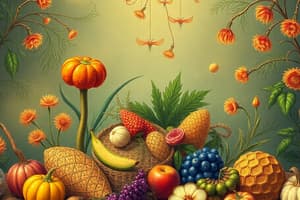Podcast
Questions and Answers
What is a characteristic of autotrophic nutrition?
What is a characteristic of autotrophic nutrition?
- Organisms rely solely on sunlight for energy.
- Organisms require oxygen to produce food.
- Organisms must consume other organisms for energy.
- Organisms produce their own food. (correct)
Which type of respiration is more efficient in terms of ATP production?
Which type of respiration is more efficient in terms of ATP production?
- Aerobic respiration (correct)
- Alcoholic fermentation
- Anaerobic respiration
- Lactic acid fermentation
What is the main function of the phloem in plants?
What is the main function of the phloem in plants?
- Store waste products
- Transport water from roots to leaves
- Transport sugars and nutrients throughout the plant (correct)
- Absorb sunlight for photosynthesis
Which of the following is a feature of closed circulatory systems?
Which of the following is a feature of closed circulatory systems?
How do plants primarily excrete waste?
How do plants primarily excrete waste?
What type of organisms are classified as saprotrophs?
What type of organisms are classified as saprotrophs?
Which of the following statements accurately describes anaerobic respiration?
Which of the following statements accurately describes anaerobic respiration?
What role do kidneys play in human excretion?
What role do kidneys play in human excretion?
Flashcards are hidden until you start studying
Study Notes
Nutrition Types
-
Autotrophic Nutrition
- Organisms produce their own food.
- Examples: Plants use photosynthesis (sunlight, CO2, water).
- Chemosynthesis in some bacteria (energy from chemical reactions).
-
Heterotrophic Nutrition
- Organisms rely on other organisms for food.
- Types:
- Herbivores: Consume plants (e.g., cows, deer).
- Carnivores: Consume animals (e.g., lions, eagles).
- Omnivores: Consume both plants and animals (e.g., humans, bears).
- Saprotrophs: Feed on decaying matter (e.g., fungi, bacteria).
Respiration Mechanisms
-
Aerobic Respiration
- Requires oxygen.
- Occurs in mitochondria.
- Glucose + Oxygen → Carbon Dioxide + Water + ATP (energy).
-
Anaerobic Respiration
- Occurs without oxygen.
- Less efficient; produces less ATP.
- Types:
- Lactic Acid Fermentation: In muscle cells, produces lactic acid.
- Alcoholic Fermentation: In yeast, produces ethanol and CO2.
Transport Systems
-
Transport in Plants
- Xylem: Transports water and minerals from roots to leaves.
- Phloem: Transports sugars and nutrients throughout the plant.
-
Transport in Animals
- Circulatory System: Transports nutrients, gases, and waste.
- Components: Heart, blood vessels (arteries, veins, capillaries), and blood.
- Types of Circulatory Systems:
- Open Circulatory System: Blood not confined to vessels (e.g., in insects).
- Closed Circulatory System: Blood confined to vessels (e.g., in humans).
- Circulatory System: Transports nutrients, gases, and waste.
Excretion Processes
-
Excretion in Humans
- Kidneys filter blood to remove waste products (urea, excess salts, water).
- Urine is produced and expelled via the urinary system (ureters, bladder, urethra).
-
Excretion in Plants
- Minimal excretion process; primarily through transpiration (loss of water).
- Waste products may be stored in vacuoles or shed (e.g., leaves).
-
Importance of Excretion
- Maintains homeostasis.
- Prevents accumulation of toxic substances in the body.
Nutrition Types:
- Organisms can be categorized based on how they obtain food
- Autotrophs are self-feeders, producing their own food
- Plants utilize photosynthesis, harnessing energy from sunlight, CO2, and water
- Some bacteria employ chemosynthesis, deriving energy from chemical reactions
- Heterotrophs rely on other organisms for their food source
- Herbivores consume plants (e.g., cows, deer)
- Carnivores consume animals (e.g., lions, eagles)
- Omnivores consume both plants and animals (e.g., humans, bears)
- Saprotrophs obtain their food from decaying matter (e.g., fungi, bacteria)
Respiration Mechanisms:
- Aerobic Respiration requires oxygen
- Takes place within the mitochondria
- Involves the breakdown of glucose with oxygen to produce carbon dioxide, water, and ATP (energy)
- Anaerobic Respiration occurs without oxygen
- Less efficient in producing ATP
- Includes:
- Lactic Acid Fermentation: Occurs in muscle cells, producing lactic acid
- Alcoholic Fermentation: Occurs in yeast, producing ethanol and carbon dioxide
Transport Systems:
- Plants have specialized tissues for transport
- Xylem carries water and minerals from the roots to the leaves
- Phloem transports sugars and nutrients throughout the plant
- Animals utilize a circulatory system for transport
- Includes the heart, blood vessels (arteries, veins, capillaries), and blood
- Open Circulatory System: Blood is not confined to vessels (e.g., in insects)
- Closed Circulatory System: Blood is confined to vessels (e.g., in humans)
Excretion Processes:
- Humans excrete waste products through the kidneys
- Kidneys filter blood, removing urea, excess salts, and water
- Urine is produced and expelled via the urinary system (ureters, bladder, urethra)
- Plants have minimal excretion processes
- Primarily excrete through transpiration (loss of water)
- Waste products may be stored in vacuoles or shed (e.g., leaves)
- Excretion plays a vital role in maintaining homeostasis and preventing the accumulation of toxic substances in the body
Studying That Suits You
Use AI to generate personalized quizzes and flashcards to suit your learning preferences.




